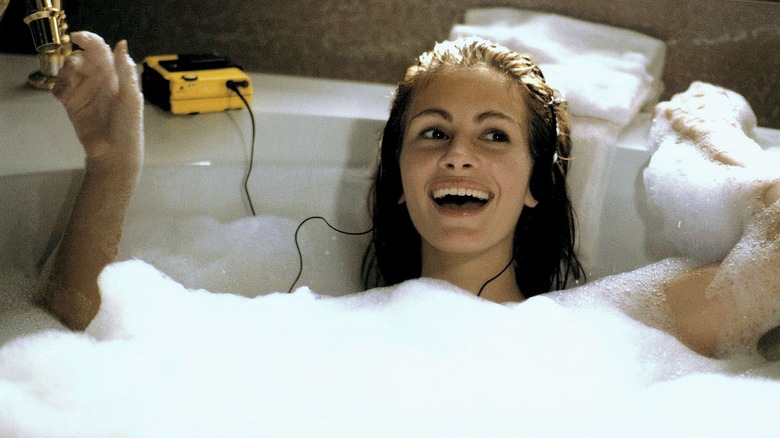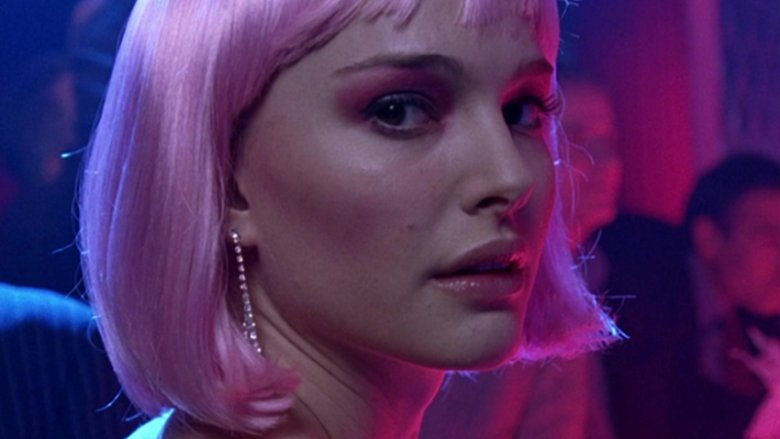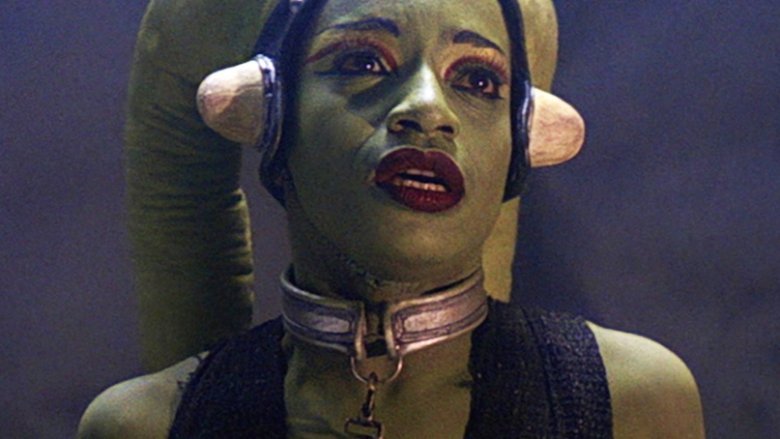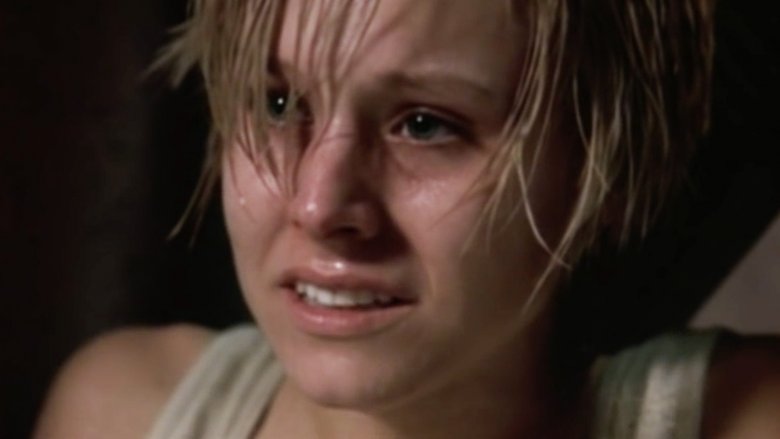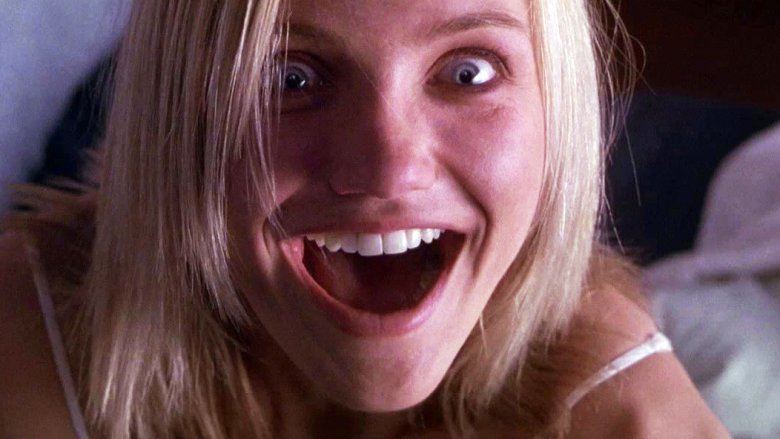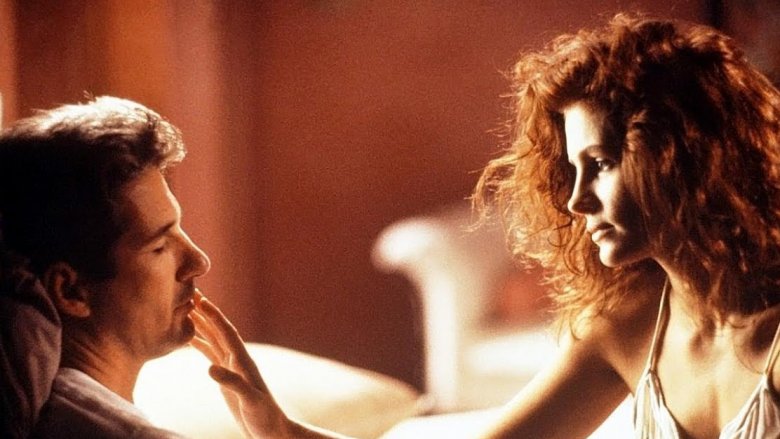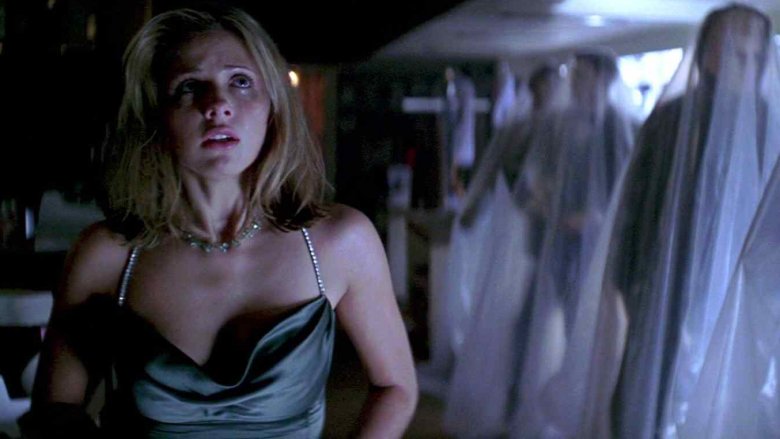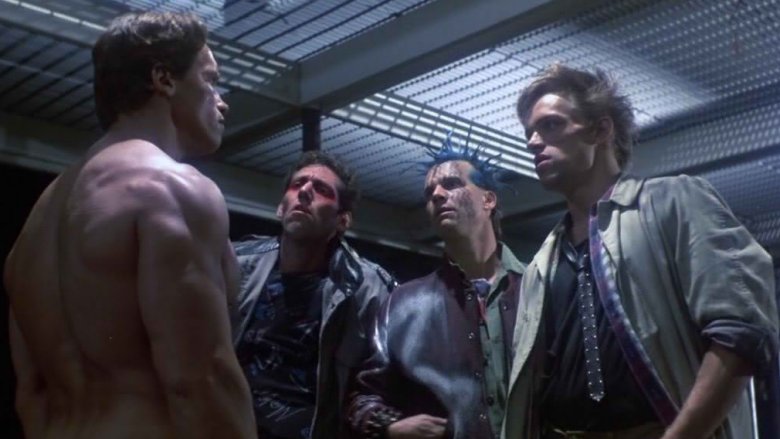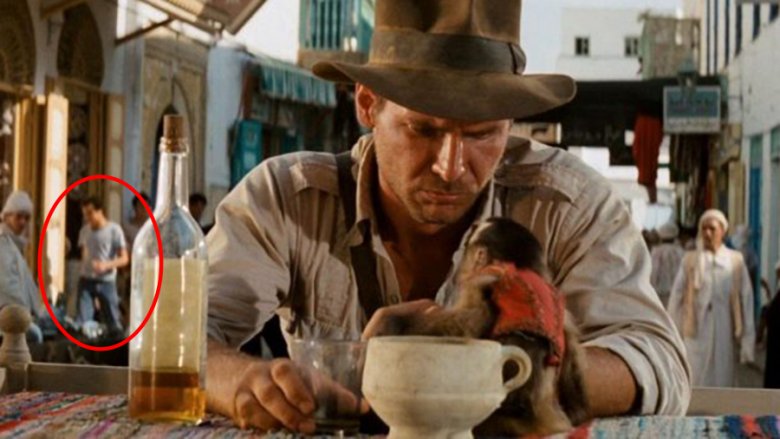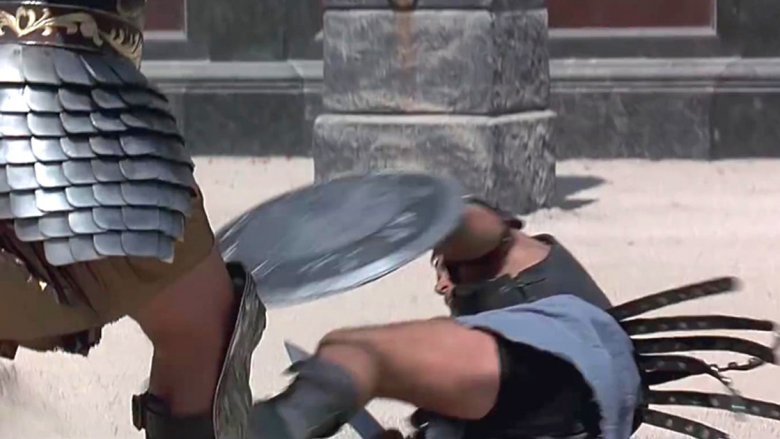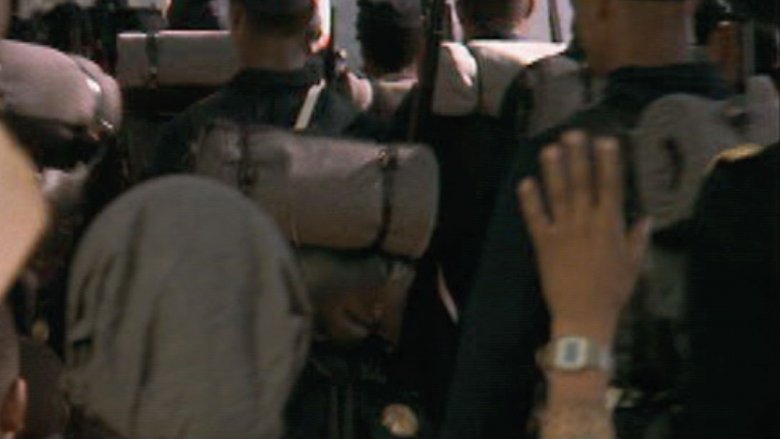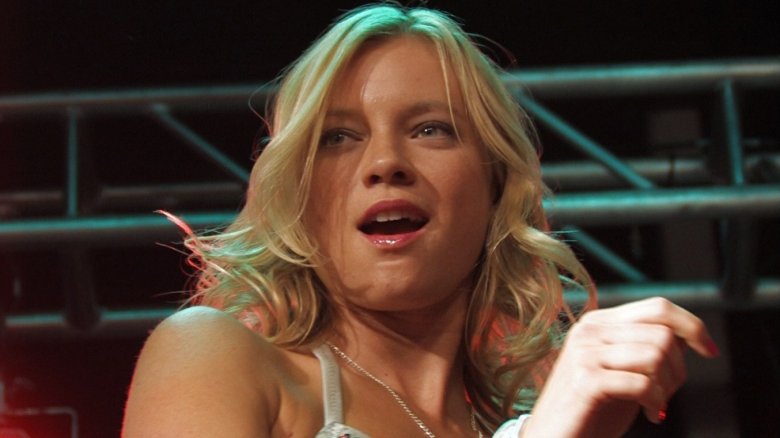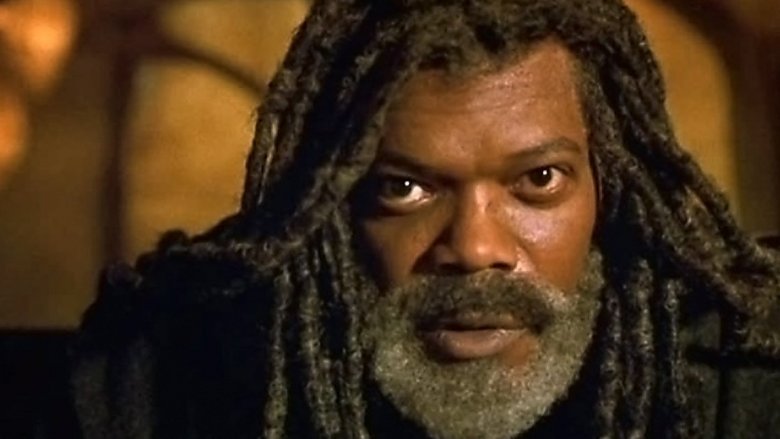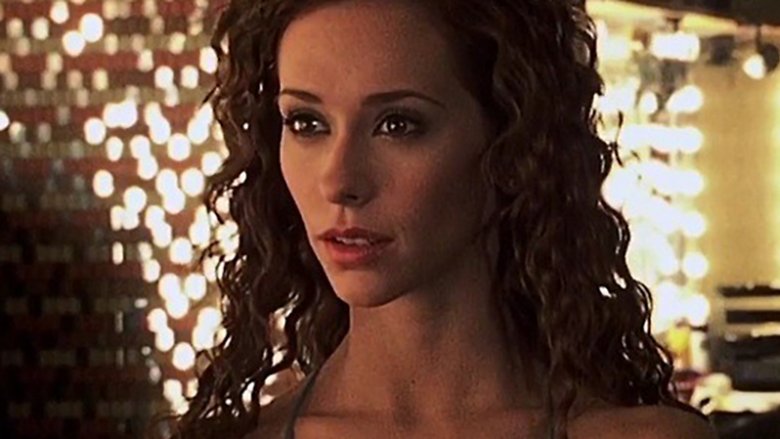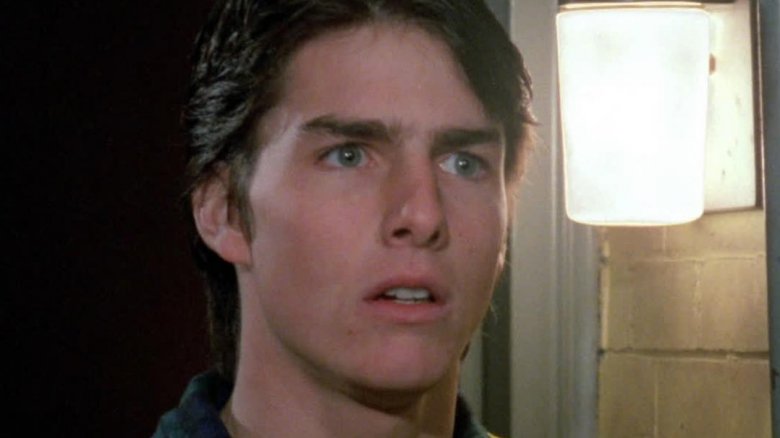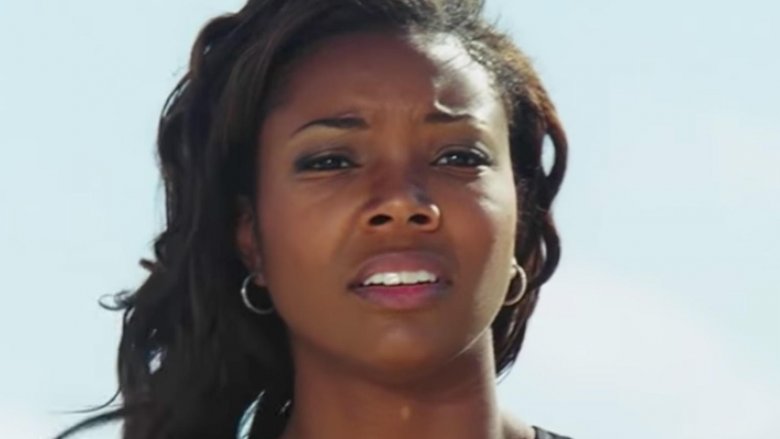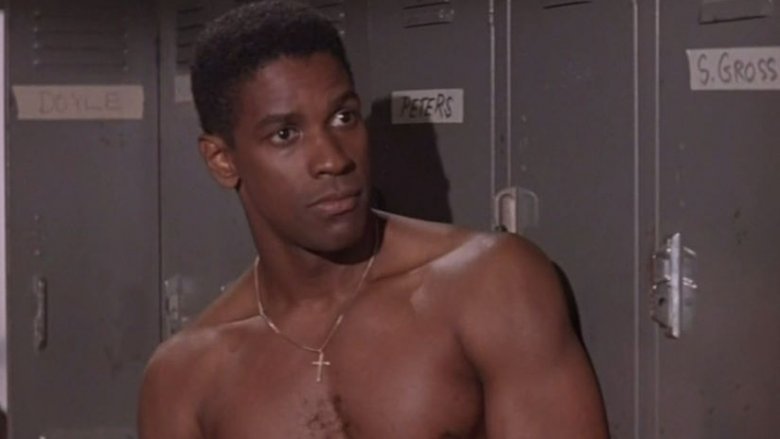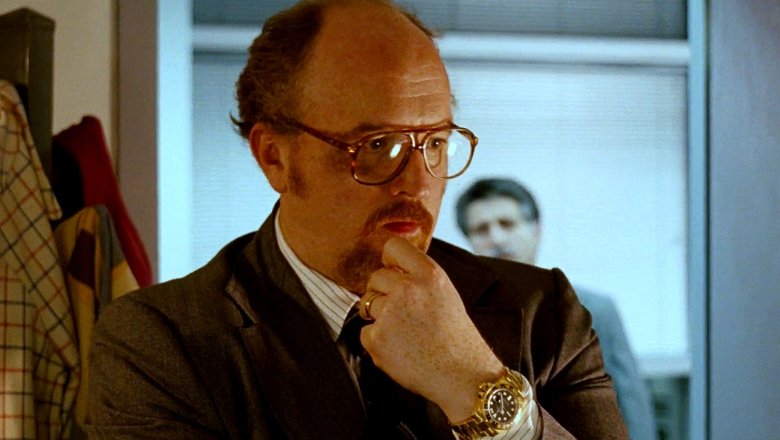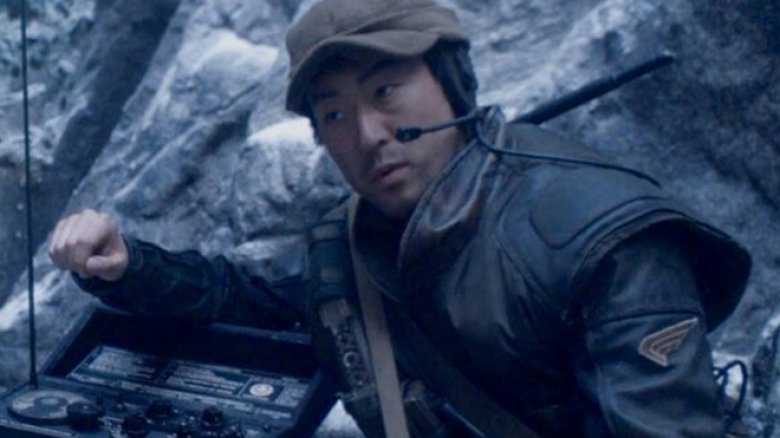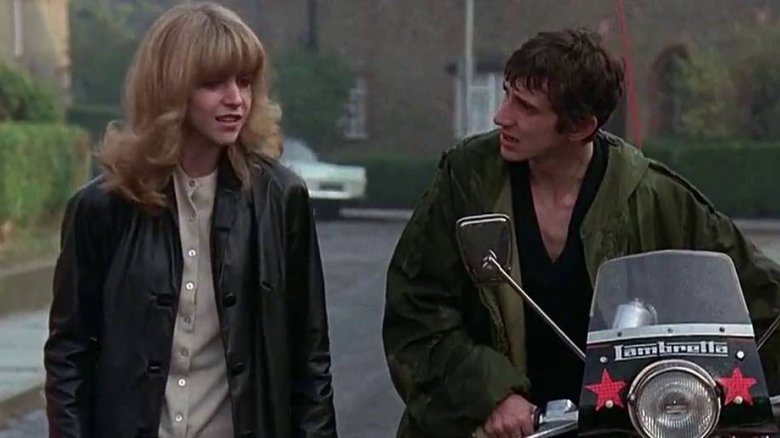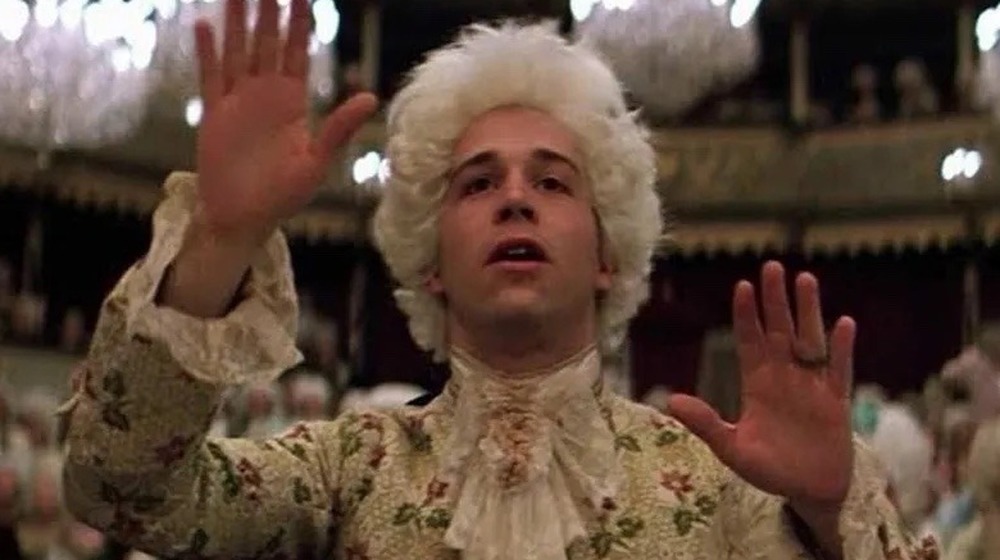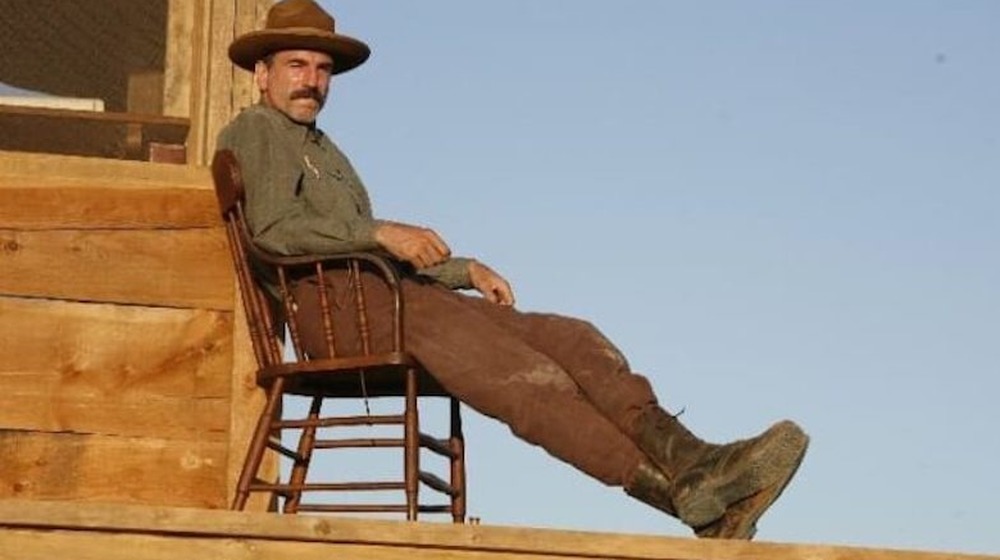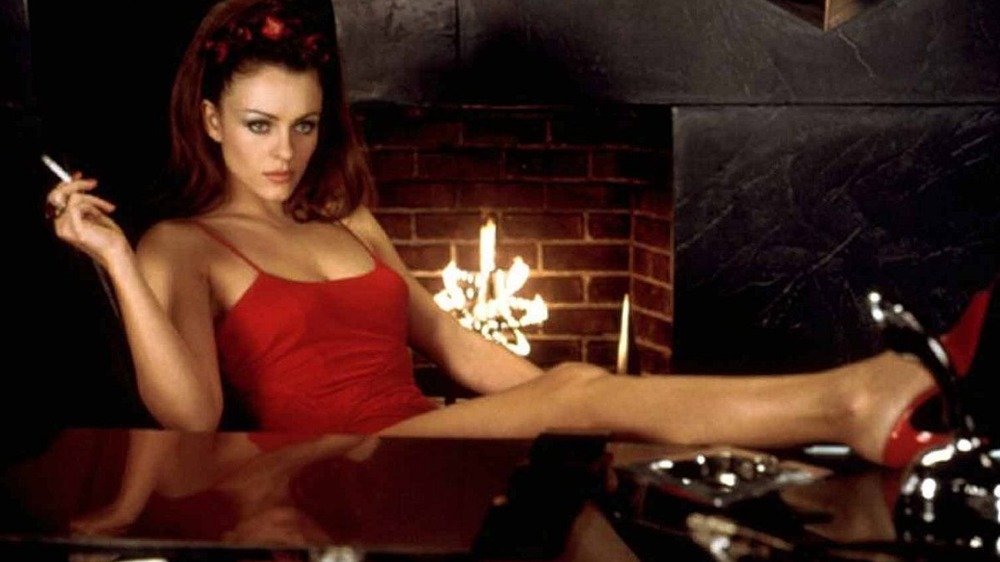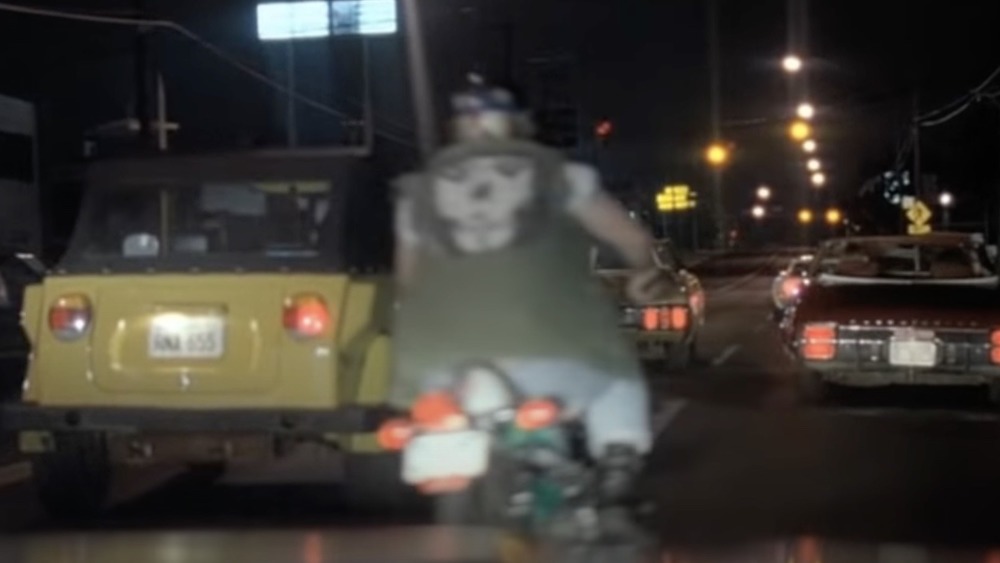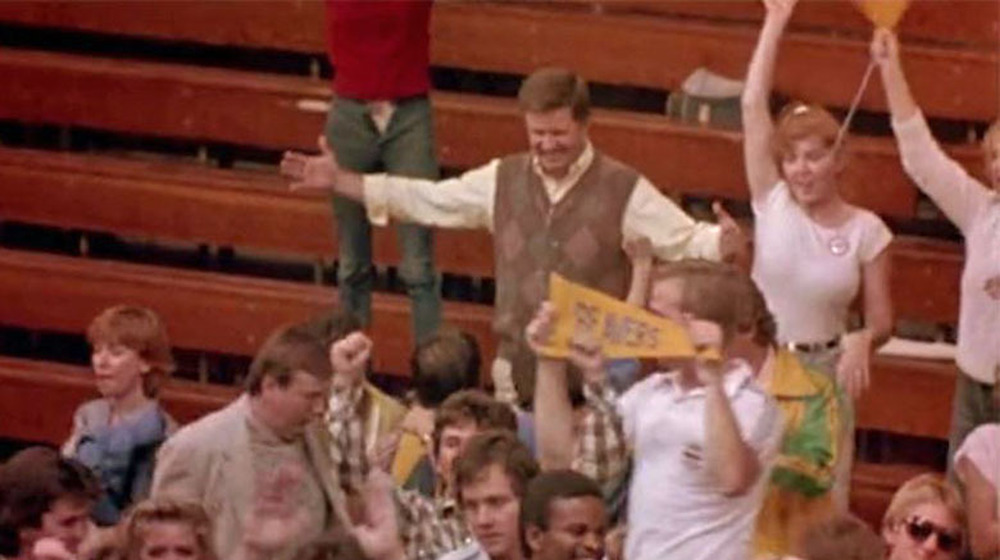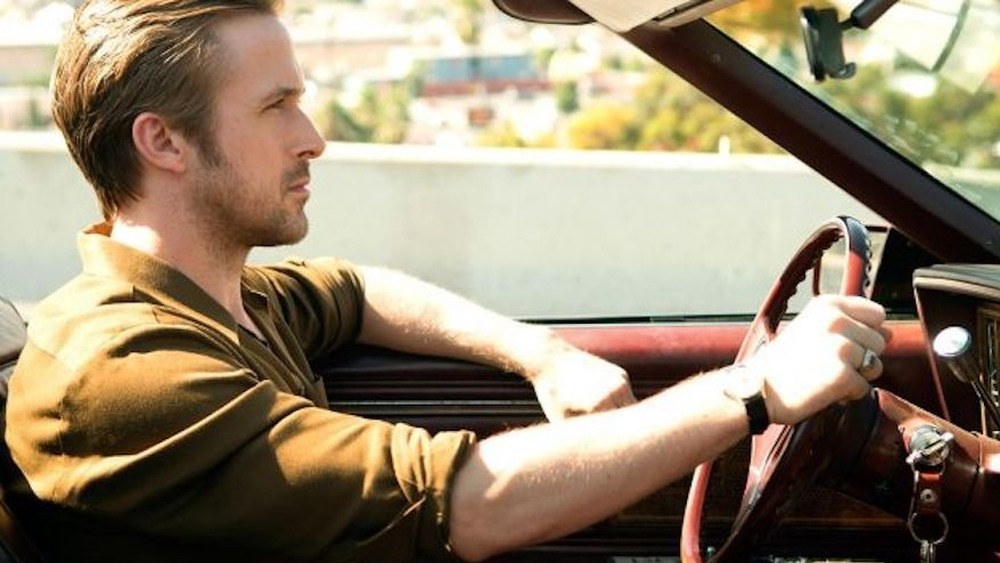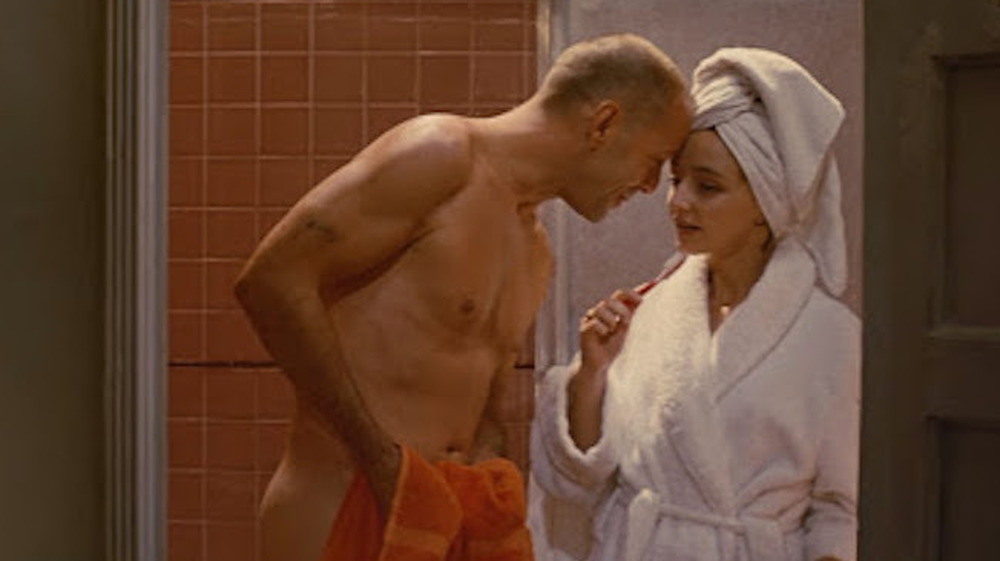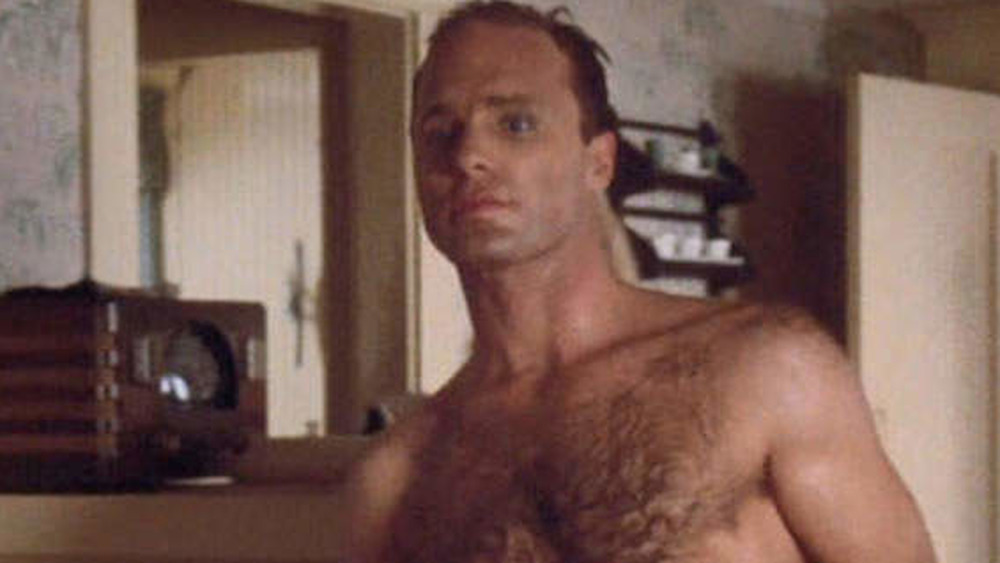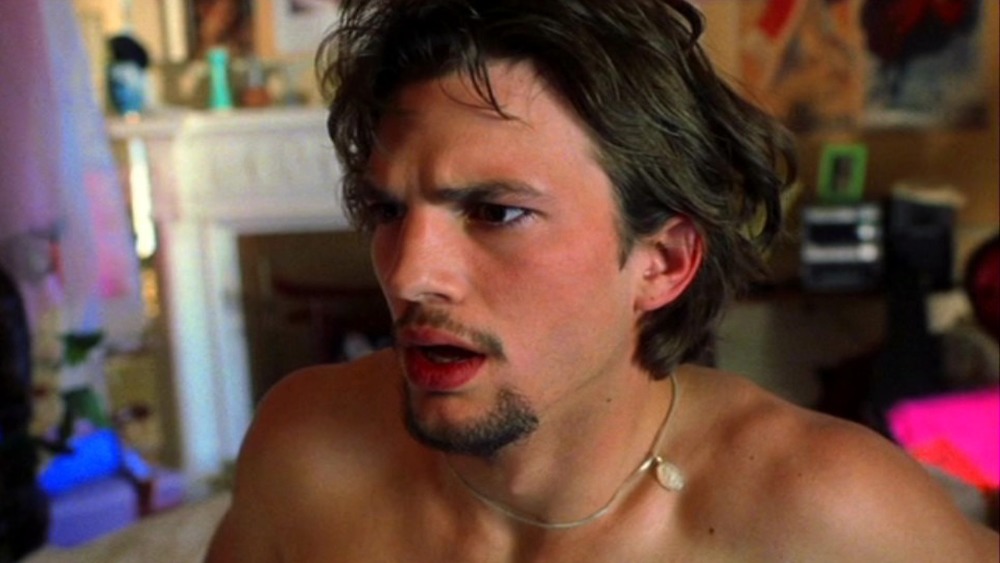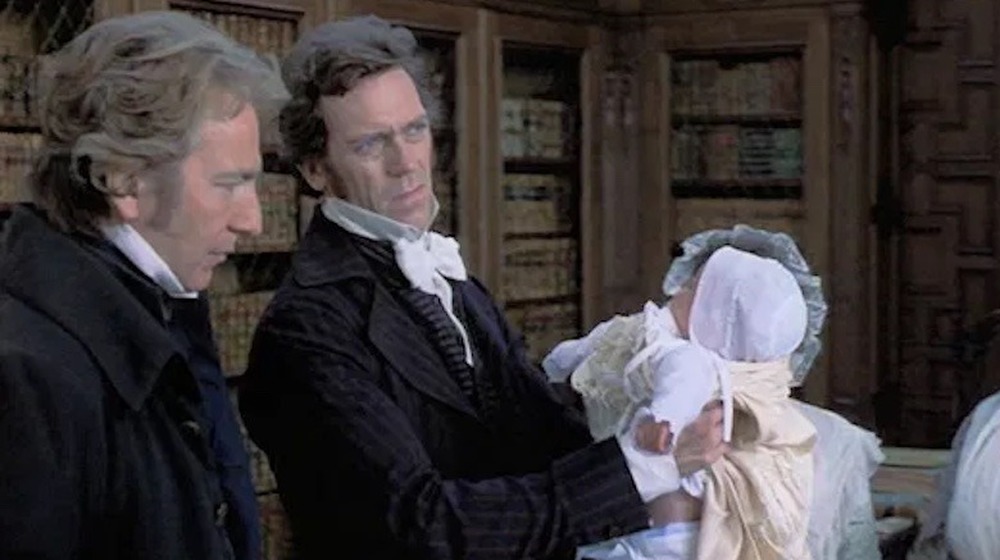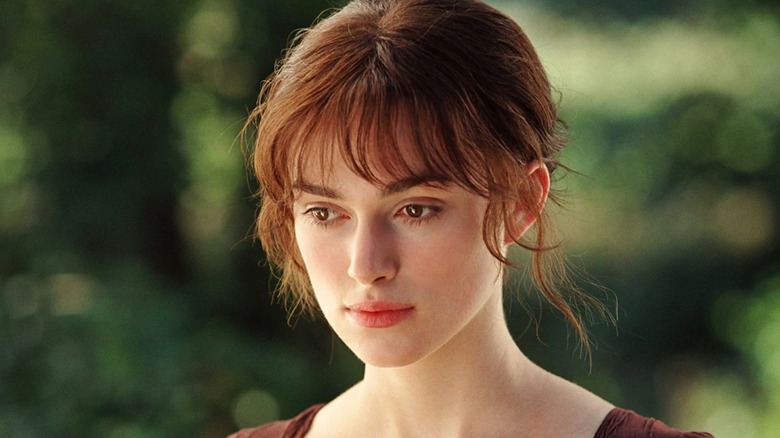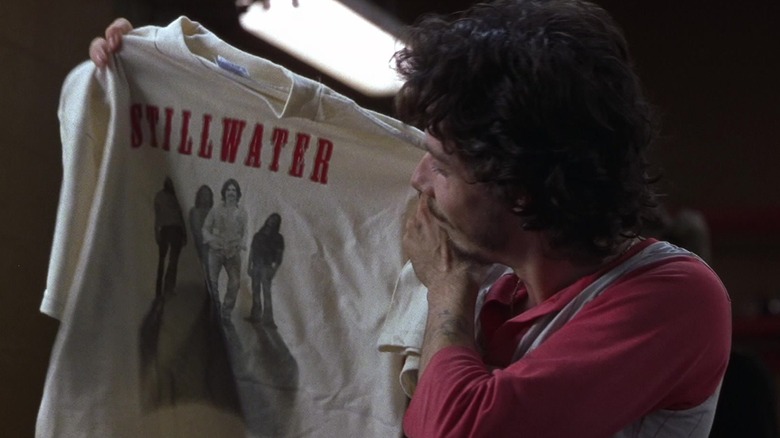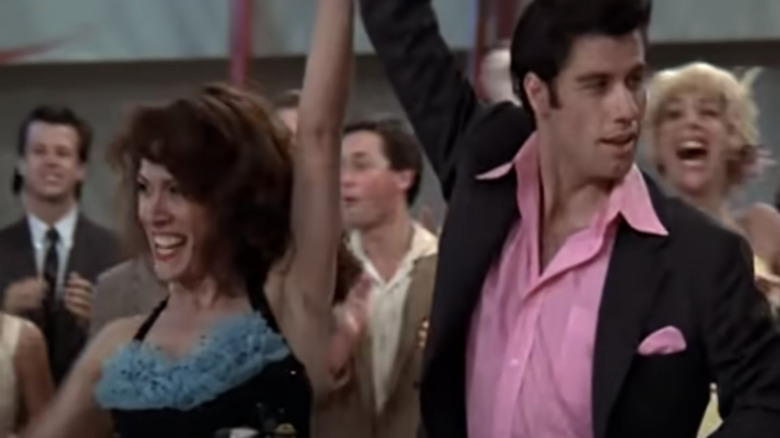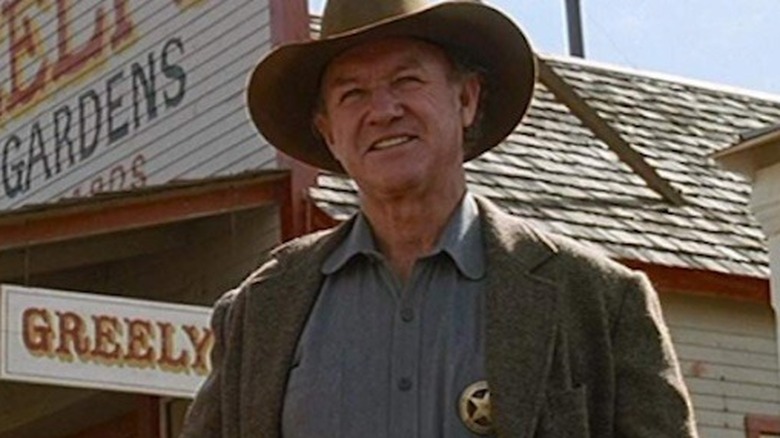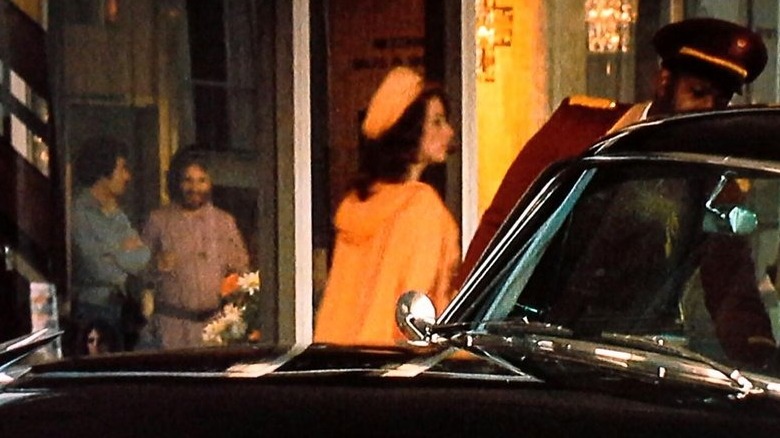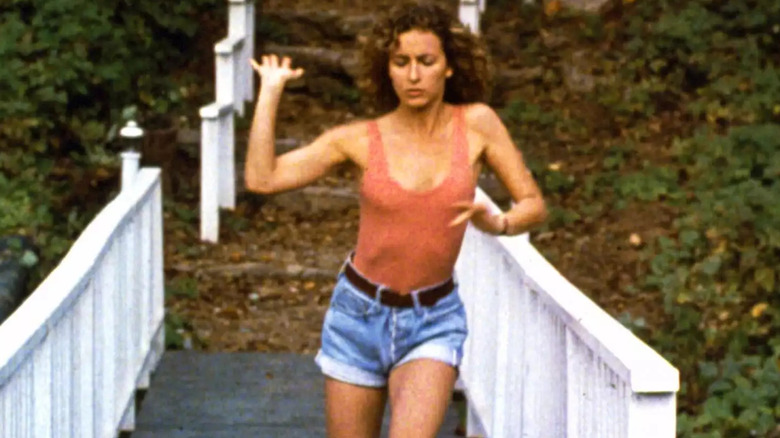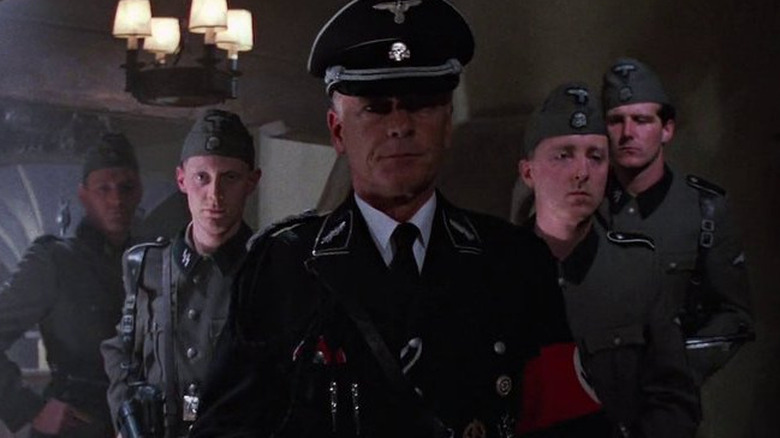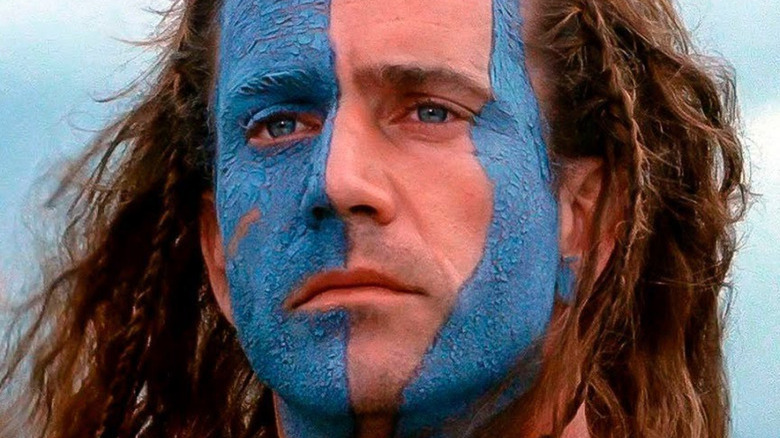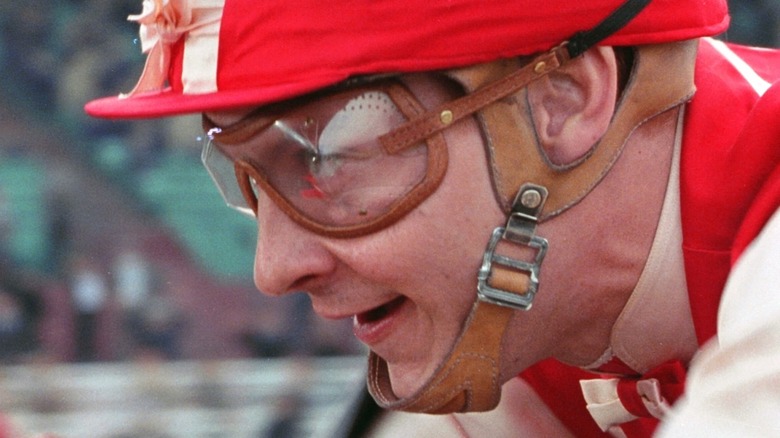Wardrobe Malfunctions That Ended Up In The Movie
In cinema, a little allure goes a long way. The mystery of what's left to the imagination, the suggestiveness of certain imagery, the scandalous nature of some film and TV scenes — Hollywood capitalizes on all that coquettishness. But sometimes the "scandal sells" approach goes a little further than intended when an actor's clothing stops cooperating and they flash more skin than they intended, or when they're simply wearing something they definitely shouldn't be.
Any skilled costume designer, dedicated director, or eagle-eyed editor would remedy accidental near-nudity or glaring mistakes on set or in post-production to ensure the public never spotted the garment glitch. That's usually how it works, too — except in the case of these wardrobe malfunctions that skated past a hundred sets of eyes and somehow ended up in the movie.
The bra slip in Closer
Even if you've never seen "Closer," Mike Nichols' Oscar-nominated film adapted from Patrick Marber's searing stage play of the same name, you've certainly seen the character Natalie Portman portrays. Bubblegum pink wig, dangling crystal earrings, and a purple star-encrusted, fringed-out bustier? That's Alice Ayres, also known as Jane Jones, the young exotic dancer from America who arrives in London, meets and falls for British writer Dan Woolf (Jude Law), and makes a pretty naughty declaration about the most fun thing a girl can do.
Though many would be forgiven for presuming Portman bares it all as Alice, they'd be mistaken, as the actress defies her character's line of work and stays totally clothed. Director Nichols reportedly destroyed all of Portman's previously shot nude scenes in the editing process, and in the final cut, she only flaunts a bit of midriff, some backside, and a peek of décolletage now and then. But thanks to a wardrobe malfunction that happens during an unfortunate moment in a booth opposite Clive Owen's Larry Gray, a lot more is shown. While talking to Owen's Larry — in an already intense scene, we might add — Portman crosses her legs over the edge of a booth, causing her bra to slip down about an inch too far. Needless to say, it ended up in the movie anyway.
The scandalous stumble in Star Wars: Return of the Jedi
There's something special about the "Star Wars" film universe's far-reaching, wide-ranging appeal. Though creator George Lucas reportedly owned up to purposely making his prequel installments more friendly to a younger audience (heck, he even created Jar Jar Binks using Disney's Goofy as an inspiration), a vast majority of "Star Wars" fanatics are adults. And apart from an innuendo or two likely meant to make the older crowd chuckle, the franchise has remained largely squeaky clean...with one notable exception.
In "Return of the Jedi," actress Femi Taylor portrays Oola, the green-skinned Twi'lek slave dancer Jabba the Hutt holds captive in his palace. Before Oola meets her grisly death at the mouth of a hungry Rancor, Jabba makes her strut about in her skimpy outfit while he watches — and grabs hold of Oola's chain during the sequence, making her stumble and causing a wardrobe malfunction that makes her costume reveal something you'd never think you'd see in a "Star Wars" movie. The slip happens in the blink of an eye, but it definitely ended up in the movie. The fact that Lucas was a stickler for scrubbing up "Star Wars" footage for home releases makes it especially bizarre that this malfunction didn't end up on the cutting room floor.
The accidental exposure in Spartan
This David Mamet political thriller is nothing if not potent, featuring a stacked cast glistening with the likes of William H. Macy, Val Kilmer, Tia Texada, Clark Gregg, and Ed O'Neill, as well as a ton of action-packed scenes that keep you riveted in shock and tension. Things get so heated in "Spartan," in fact, that one of the film's brightest stars, Kristen Bell, falls victim to a bosom-centric wardrobe malfunction during a fight scene. Bell, who portrays the fictional U.S. President's missing daughter Laura Newton, takes a punch so powerful that it sends her tank top all askew. The result? She unwittingly flashes the audience. Clearly, the editors didn't think it scandalous enough to snip out.
The shifty nightgown in Vanilla Sky
Watchers of "Vanilla Sky" aren't left wanting additional adrenaline-pumping action, an extra smattering of stirring sci-fi, or more eyebrow-raising decisions that make Tom Cruise's character seem genuinely dangerous. One of the most noteworthy scenes in the film involves such a move made by Cruise's David Aames, who captures Cameron Diaz's Julianna "Julie" Gianni, his one-time lover, and straps her to the bed. Diaz, wearing a sheer dress, attempts to flip herself over on the mattress, and in doing so, accidentally shifts the top of the garment out of place. The actress is quick to fix the wardrobe malfunction mid-scene, pulling the gown into its original position, but the chest-exposing take wound up in the film's final cut.
The too-sheer shift in Pretty Woman
Julia Roberts is another Hollywood pro who understands the perils of a too-see-through nightie and the complexities that come with playing a character whose morals are a heck of a lot looser than her own. The actress' staunch stance against going nude for the silver screen wouldn't seem to jell well with her role as "hooker with a heart of gold" Vivian Ward in "Pretty Woman," but, like Natalie Portman in "Closer," Roberts remained covered up over the course of the film.
However, when one scene sees Roberts' Vivian strip down (offscreen, of course) into her skivvies for an intimate night with Edward Lewis, the full-time corporate raider and part-time womanizer played by Richard Gere, audiences get a clear view of exactly what Roberts was trying so hard to keep hidden. While many may assume that the bare-chested shot is actually of Roberts' body double, since she reportedly used one (Shelley Michelle, to name names) for some up-close sequences in "Pretty Woman," her face is visible in the moment of malfunction.
The dastardly dress in I Know What You Did Last Summer
Acts of physical passion and a focus on human anatomy are closely linked to the horror genre, what with all the sexy scenes sprinkled between slayings, so it doesn't come as too much of a surprise to hear that Jim Gillespie's 1997 slasher "I Know What You Did Last Summer" includes a touch of sensuality. That's all well and good — until such a moment pops up in an otherwise completely innocent scene. As Sarah Michelle Gellar's character Helen Shivers, a gal who's definitely not the brightest tool in the shed, desperately tries to escape death, she attempts to climb a rope up to safety and away from the killer. Her decision is a pretty dim one, but it's nothing to think twice about — that is, until the camera shows Gellar frantically pulling the rope toward herself and we see what's underneath her shiny, ill-fitting dress.
The saucy stroll in The Terminator
Even the former "Governator" has suffered an incident on the set, experiencing a wardrobe malfunction countless fans have since noticed — and the director and editors apparently didn't. During the opening scene of 1984's "The Terminator," Arnold Schwarzenegger (as the title character) walks around in his birthday suit before he gets the chance to cover up. Low lighting, clever distant camera angles, and the stereotypically poor quality of the original 1980s footage preserve Schwarzenegger's dignity for the most part, but those naughty bits still made it into the movie — the remastered Blu-ray edition shows the actor stark naked and on full display as he approaches a group of young ruffians.
The bold background character in Raiders of the Lost Ark
Director Steven Spielberg's lively adventure pic "Raiders of the Lost Ark" keenly depicts Egypt in the mid-1930s. But between the earth-toned trinkets and the intricate tapestries that line the city markets, there's something (or someone, rather) that ruins the atmosphere. Look closely in the background of one particular scene, just behind Harrison Ford's Indiana Jones, and you'll spot an extra wearing blue jeans and a T-shirt, casually co-mingling with Egyptian locals in traditional outfits as if he doesn't stick out like a major sore thumb. This wardrobe malfunction wouldn't get so much as a passing glance in 1981, the year the film was shot, but it attracts all the wrong kind of attention in 1936, when the story takes place.
The anachronistic undies in Gladiator
In the same vein as the "Raiders of the Lost Ark" blunder, there's a moment in "Gladiator" when some era-inappropriate garments make a guest appearance. Russell Crowe takes the lead in this Ridley Scott historical epic as Hispano-Roman general Maximus Decimus Meridius, a man bent on vengeance following the murder of his family. All-out brawls and impassioned sparring sessions are requisites when it comes to getting back at the person who killed your loved one, and Crowe's Maximus does just that, making each move appear realistic and adding to the overall immersion of the film. What ripped some viewers out of this intense watching experience, however, is the wardrobe malfunction that's visible in the middle of one such fight scene. Crowe's Maximus falls to the ground, his derriere directly facing the camera, and exposes a pair of Lycra shorts under his tunic. The elastane fiber material is great for modern-day workouts, but has no place in ancient Rome. Alas, it still made it into the movie anyway.
The watch in Glory
Starring Matthew Broderick, Denzel Washington, Cary Elwes, and Morgan Freeman, helmed by Academy Award-winning filmmaker Edward Zwick, "Glory" earned well-deserved accolades when it debuted in 1989. Critics lauded the American Civil War-set film for its breathtaking cinematography, its stellar cast, and its emotionally resonant narrative. What they loved even more than all that was how the creative team paid "enormous attention to period detail," praise that's incredibly ironic considering a major wardrobe malfunction that made it to the theatrical cut.
One child, standing in the foreground of a scene, sticks his arm in the air as packs of his peers walk around him. On his wrist, he's rocking a silver and tan digital watch, a piece of technology that without a doubt wouldn't have been around in 19th-century America. The actor in question should have slipped his accessory off before stepping on set, or someone — anyone — else should have caught the mistake.
The uncooperative underwear in Crank: High Voltage
The 2009 sequel to directors Mark Neveldine and Brian Taylor's black comedy action thriller, "Crank: High Voltage" isn't exactly the kind of cinematic fare that would warrant high-necked tops, floor-length skirts, and modest suits. Instead, it's the binary opposite: plenty of exposed skin (think perpetually unbuttoned tops and jackets; sleeveless, tattoo-revealing tees) for the guys and skimpy outfits for the girls. Actress Amy Smart, who plays Eve Lydon, gets the tiniest get-up of the bunch: a pair of itty-bitty bottoms that are more like underwear than shorts. Basically, they're a wardrobe malfunction waiting to happen. And, with the help of some awkward camerawork, one does.
When Smart's Eve hops on the back of a motorcycle in a getaway scene (the cops are after her and Jason Statham's Chev Chelios), the camera suddenly shifts to focus on her backside, where viewers get a super intimate look at her underwear. Because there wasn't enough material to cover her properly as she slid herself onto the bike's seat, the audience also gets a look at a whole lot more.
The unintentional flashing in The Caveman's Valentine
Considering that Samuel L. Jackson has previously expressed his view that nude scenes are "extremely awkward" to film, and admitted that he isn't quite sure his manhood is "formidable" enough to "fill [his] aura," you'd be right to assume that the prolific actor has never in his decades-long career sauntered around in his birthday suit for a movie. As it happens, however, you'd be wrong.
In the 2001 drama pic "The Caveman's Valentine," known as "Sign of the Killer" in certain countries, Jackson strips down and struts past a mirror in a scene likely meant to show off only his buttocks. But, as most malfunctions go, so much more than intended was caught on camera. In a flashbulb moment while his backside is on display, viewers can see Jackson's frontside, too. "The Caveman's Valentine" never got a Blu-ray release, meaning no one will ever see a high-resolution shot of Jackson's nether region, so his dignity is at least partly preserved.
The slippy dress in The Tuxedo
Like Julia Roberts, Jennifer Love Hewitt is known for her no-nudity-in-films attitude. (She once told People that baring it all isn't something she feels "particularly comfortable with," and that she thinks it's "sexier not to show everything" since "imaginations can do way more.") While she may not have intentionally tossed her inhibitions and her clothes to the corner for a flick, Love Hewitt has actually been partially naked on camera before.
Kevin Donovan's comedy–action film "The Tuxedo" stars Love Hewitt as the genius scientist Delilah "Del" Blaine, who finds herself in the clutches of a villain intent on drowning her. When he drags her into the pool, Love Hewitt thrashes about wildly — giving a convincing performance as someone who really doesn't want to die a water-logged death, but also giving watchers a flash of her chest as her thin blue dress slips to the side. She isn't exposed for long, and the garment slides back into place the next moment, but the resultant tornado of bubbles that swirls around her can't completely hide what happened.
The scandalous swim in Gallipoli
Peter Weir's 1981 Australian drama war film "Gallipoli" is noteworthy for a few reasons: It took home a grand total of eight Australian Film Institute awards, boomed in the box office down under, earned a Golden Globe nomination for Best Foreign Film in 1982, and fared well with critics. It's also become known for a vastly different reason: "Gallipoli" features a bit of Mel Gibson nudity.
A then-25-year-old Gibson shows off everything he's got during a scene in which his character — Archy Hamilton, the stockman and sprinter with his sights set on the Australian Imperial Force — sheds his colors to go for a swim with his soldier pals. When he dives down to the seafloor, we end up seeing more of Gibson's "downstairs" than we should have. Gibson clearly wasn't given any costume modifications to help prevent any slippage, and the shot wasn't clipped out of the theatrical or home release versions of the film. To make the situation even more eye-popping, "Gallipoli" is rated PG!
The wrong move in All the Right Moves
Tom Cruise is a pretty bold dude. From professing his love for now-ex-wife Katie Holmes to Oprah in that infamous couch-jumping incident to his dedication to performing dangerous (and potentially deadly) stunts, the guy is about as far removed from the word "meek" as one can get. Back in 1983, however, Cruise was just a 21-year-old kid who landed a role as Serbian-American high school student and aspiring college football player Stefen "Stef" Djordjevic in the sports drama "All the Right Moves." Cruise dipped his feet into daring waters for the film, baring it all for a sex scene with Lea Thompson, who played his onscreen girlfriend Lisa Lietzke. The actor ended up making a wrong move during the scene, though, and his bits were clearly visible for a few seconds. Plenty of other aspects in "All the Right Moves" warranted the film's R rating, but the fact that this malfunction made it to the final cut could have bumped it to an X instead.
The too-tight dress in Bad Boys II
The Michael Bay-directed "Bad Boys II" is a small slice of heaven for any fan of the buddy cop and action-comedy genres. It's got a leading duo (Martin Lawrence as Marcus Burnett and Will Smith as Mike Lowrey) who work off one another's attitudes and push each other's buttons; a high-stakes mission the pair have to embark on; a seemingly indomitable villain; and the ubiquitous beautiful and badass woman who ends up a love interest for one of the protagonists. Gabrielle Union is that more-than-a-pretty-face character in the film (she plays Special Agent Sydney "Syd" Burnett), so it's unsurprising that she's seen sporting some revealing outfits. One in particular is a little too low-cut, however.
In a scene where Union's character chucks a gun toward a live minefield and then ducks for cover, her cut-out dress slides sideways to reveal her nipple. In real time, the malfunction is a bit hard to spot, but slow down the footage just a tad, and you'll see Union's chest clear as day.
The showy skip in Ricochet
Denzel Washington leads "Ricochet," the 1991 action crime thriller from director Russell Mulcahy, playing LAPD Detective-Lieutenant and Assistant District Attorney Nicholas "Nick" Styles, who spends a good chunk of his time with his fellow law enforcement officers, either in the field or chatting it up in the locker room. The latter is where Washington falls prey to a sneaky wardrobe malfunction. As a fully nude Washington leaps up from the locker room bench to hide behind a locker door when a woman enters the men-only zone, his manhood gets a fraction of a second of fame. An untrained eye wouldn't be able to zero in on the explicit shot, but if one looks just carefully enough, they'll be able to see it.
The trendy timepiece in American Hustle
With its pitch-perfect soundtrack, superb costume design, and fine-tuned set design, David O. Russell's "American Hustle" is a sublime period pic and an excellent snapshot of the sights and sounds of the 1970s. Main cast Christian Bale, Amy Adams, Bradley Cooper, Jennifer Lawrence, and Jeremy Renner look straight out of the disco-crazed decade, and so does supporting actor Louis C.K. as Stoddard Thorsen — except for one wardrobe detail that got completely overlooked and made multiple appearances in the movie. The Rolex C.K.'s Thorsen wears is actually a huge anachronism. It isn't an era-appropriate accessory like some may assume; rather, it's a solid-gold 116718LN GMT-Master II model Rolex with a ceramic bezel, a watch that was first manufactured around 2010.
The erroneous earpiece in Captain America: The First Avenger
On the whole, "Captain America: The First Avenger" is a solid piece of entertainment. It shot star Chris Evans further into superstardom, spawned two sequels ("Captain America: The Winter Soldier" and "Captain America: Civil War"), and has stood as one of the most well-loved Marvel movies in history. It's hard to pick it apart too much is what we're getting at. But in the midst of all the "pulpy action" and "pleasantly retro vibe" that the critics applaud in "Captain America," there's a historical slip-up we can hardly believe made it into the film. About an hour and a half in, during the train raid scene, Kenneth Choi's Jim Morita is shown wearing a high-tech earpiece — what looks to be a Bowman Communication military headset — which definitely didn't exist during WWII.
The off-target T-shirt in Quadrophenia
When it comes to the world of music, you can tell a lot by a person by what they listen to. Beyond that, you can also learn a lot about someone's musical tastes by what they wear around town. That means you can probably spot a rock fan, a metal fan, or a rap fan based on the clothes they wear and the bands they rep on their clothes. But what about time travelers?
A film that chronicles the early 1960s conflicts between the warring mod and rocker subcultures in Britain, "Quadrophenia" should have taken extra precaution to ensure that everything looked accurate for a story set during the decade of free love, Beatlemania, and sexual liberation. Unfortunately, a glaring error was made ... and was left in the final cut. One character sports a shirt repping Motörhead, the English rock band that formed in June of 1975 — over a decade after the year in which "Quadrophenia" takes place.
The prominent zippers in Amadeus
"Grand" would be a good word to describe "Amadeus," Miloš Forman's film version of Peter Shaffer's play that purports to tell the story of the last days of famous composer Wolfgang Amadeus Mozart (Tom Hulce), and the hatred felt by his rival and contemporary musician, Antonio Salieri (F. Murray Abraham). "Amadeus" won eight Academy Awards in 1985, including Best Picture, Best Director, Best Actor (for Abraham), and Best Costume Design. The head of wardrobe, Theodor Pistek, brought the lush and elaborate world of late 1700s high society Vienna to life, outfitting the actors in exquisite wigs, waistcoats, lace, frills, and petticoats. Pistek also put a lot of zippers on the Amadeus costumes. In the scene depicting the ballet in Mozart's opera "The Marriage of Figaro," dancers are shown with those telltale metal teeth on their outfits. The problem with this is that zippers did not exist in 18th century Austria. The modern zipper was still about 100 years off the film's setting.
The wrong boots in There Will Be Blood
Paul Thomas Anderson's "There Will Be Blood" is the story of an oil man, a tyrant of a greed-driven tycoon named Daniel Plainview, fascinatingly portrayed with shocking brutality by Daniel Day-Lewis, who received his second of three Best Actor Academy Awards for his work as a driving force of the California oil boom in the late 1800s and early 1900s. Plainview aggressively cajoles and bends rivals and allies alike to his will, traipsing all over others metaphorically when he's not traipsing literally around his forever increasing land holdings dotted with big, noisy oil derricks. Such labor requires a solid, reliable, and sturdy pair of work boots, and Plainview can be seen wearing a pair of brown leather ones. They look suitably expensive, but they also look unsuitably modern. During a moment of rest, the camera shows the bottom of Plainview's boots, and they bear a waffle pattern, the kind found on early Nike running shoes. The latter is widely acknowledged as the originator of that kind of groove — which it pioneered in 1972, decades after the California oil boom.
The extremely high-slit dress in Bedazzled
The 2000 supernatural comedy "Bedazzled" is a remake of a 1967 film of the same name. The original starred British comedian Peter Cook as a charming version of the Devil, looking to acquire the soul of lovelorn nerd Stanley Moon (Dudley Moore) in exchange for some life-changing magic. In the 2000 version, Elizabeth Hurley is the Devil, and she plays the mistress of all that is wicked as a strong, sexy, aggressively flirty type who can easily manipulate Brendan Fraser's geeky Elliot Richards into parting with his soul. Hurley spends most of her scenes in scant, provocative, body-hugging costumes, including a devil-red dress with a leg slit that goes all the way up. Hurley's Devil is wearing this in one of her first interactions with Elliot, inviting him into her unholy office to sign the soul-selling paperwork. As she sits down at her desk, the fabric of the dress flits away for a moment, revealing, well, whatever is underneath. Fans of the film continue to debate what, exactly, Hurley flashes, be it a skimpy undergarment or a lack of skimpy undergarment.
The time-traveling biker vest in Dazed and Confused
"Dazed and Confused" is one of the best teen movies of all time, a personal and casually realistic look at the night after the last day of school in a Texas town in 1976. Nothing much really happens in Richard Linklater's re-creation of his own youth at the dawn of the American bicentennial summer, just like what happens when real kids get together, both then and now. Early in the film, as darkness falls, characters Pickford, Michelle, Slater, Jodi, Clint, and others cruise around town in their cars. During a scene shot from the point of view of one of these teens as they navigate traffic, a motorcyclist weaves around them, and he wears a vest-type jacket adorned with an illustration of a scary skull face. That's the logo of the dark punk band the Misfits, the group that would launch Glenn Danzig to fame. That's an anachronism. "Dazed and Confused" takes place in 1976, a year before the band formed, and five years before it publicly unveiled the skull logo.
The obviously open fly in Teen Wolf
In the 1980s, VHS cassettes were the state-of-the-art form of media distribution, and without an internet, salacious rumors and news about movies spread via word of mouth. These are the factors that spread the notion that there was a moment of accidental near nudity in the 1985 horror comedy "Teen Wolf." Pause the tape at just the right moment, the rumor said, and viewers would see an extra in a crowd shot with the fly of their pants wide open, and the white underwear beneath fully visible. (Or, because VHS tapes weren't exactly high-resolution, some people claimed to see male genitalia.) The scene in question is a high school basketball game in which the titular teen wolf Scott Howard aggressively competes. The crowd cheers, and a shot of a spectator in the grandstands made it into the final cut of the film, and the zipper of their pants is indeed unzipped. White fabric is obviously there, but nothing more graphic than that.
The magically changing shirt in La La Land
"La La Land" both does and doesn't capture the feel of life in modern-day Los Angeles. For example, there are very few spontaneous, expertly choreographed musical numbers on the freeways surrounding the City of Angels, but widespread L.A. does revolve around commuting — countless Angelenos spend hours a day in their cars getting from one side of the area to the other, enduring all of the requisite annoyances and mishaps. At one point, Sebastian (Ryan Gosling) and Mia (Emma Stone) are both present for an incident of road rage. During that sequence, jazz pianist Sebastian wears an appropriately retro-flavored brown shirt. In the next scene, he arrives at his apartment to see his sister, Laura (Rosemarie Dewitt). But by that time, he's wearing a blue shirt, despite not having had the opportunity or time to change. After Laura takes off, Sebastian sits down at the piano, and he's once again dressed in that brown shirt. This is not a magical shirt, nor were scenes of Sebastian furiously switching shirts cut out — it's a continuity error, which "La La Land" director Damien Chazelle acknowledges in a commentary track on the DVD of the film.
The slipping towel in Pulp Fiction
"Pulp Fiction," Quentin Tarantino's stylish, Oscar-winning Los Angeles-based 1994 crime saga, thoroughly earns the R rating bestowed upon it by the Motion Picture Association of America. The F-word is uttered more than 260 times, a character suffers a near fatal drug overdose, and there's violence throughout, like the parts when Vincent Vega (John Travolta) accidentally shoots a man at point-blank range in a moving car, or when boxer Butch (Bruce Willis) unloads dozens of bullets into an unsuspecting Vincent while he sits on a toilet. Despite all that tawdry stuff, there's very little in "Pulp Fiction" in the realm of sexuality. There's only one bit of nudity, and it was seemingly accidental. During a quiet moment when Butch hides out with his girlfriend Fabienne (Maria de Medeiros) after refusing to throw a boxing match, he takes a shower. When he gets out, he grabs a towel while Fabienne brushes her teeth, but Willis doesn't hold the fabric high enough, thus revealing his manhood to moviegoers. Later, when "Pulp Fiction" aired on television, the towel was digitally stretched to cover the uncovered parts of Butch.
The ineffective towel in Swing Shift
Before he became the go-to guy for filmmakers looking to cast middle-aged authority figures in prestigious dramas like "Gravity" and "The Truman Show," and before his four Academy Award nominations, Ed Harris was a smoldering young actor. After his breakthrough role as real-life test pilot and astronaut John Glenn in the 1983 movie "The Right Stuff," Harris starred as naval serviceman Jack Walsh in Jonathan Demme's World War II-homefront-set romantic drama "Swing Shift." It's a movie about love, relationships, and physical displays of affection, but it's very clean, earning a PG rating from the Motion Picture Association of America. Those de facto censors apparently didn't notice a quick scene of full-frontal male nudity. In one sequence, Harris's character emerges from a shower and wraps himself in a small bath towel. As he dries off his hair with another towel, he plops down in an easy chair, and the camera catches Harris' entire male anatomy when the towel rides up.
The too-loose boxers in The Butterfly Effect
The 2004 sci-fi drama "The Butterfly Effect" gave Ashton Kutcher a chance to show the world more of himself in an attempt to prove that he was capable of portraying more than just goofballs like Michael Kelso on "That '70s Show." In the film, he played a college student named Evan who discovers that when he blacks out, he can travel back in time and relive his life, fixing mistakes and righting wrongs before they happen... only to realize they have devastating consequences in the present day. After one such time-hopping episode, Evan returns to his adult life and wakes up in bed, surprised to be next to someone he doesn't think he should be with, the result of his altering of the timeline. Kutcher-as-Evan scrambles away out of concern and alarm, clad only in a pair of loose-fitting white boxer shorts. As Kutcher moves, he shows the world a little more of himself than intended, when his hidden parts briefly emerge from his underwear.
The modern diaper in Sense and Sensibility
Adaptations of Jane Austen's novels "Persuasion," "Emma," "Mansfield Park," and "Sense and Sensibility" delighted critics and audiences in the 1990s. Even though they were all set in the early 1800s, known as the Regency era in British history, modern audiences looked past the period costumes, highly mannered behavior, and constant discussions of marrying off daughters and sisters to see the universal themes of love, friendship, and empowerment.
Arguably the most successful '90s Austen-based project was 1995's "Sense and Sensibility," which won cast member Emma Thompson a screenwriting Oscar and elevated the outside-the-U.K. fame of her co-stars Kate Winslet and Hugh Laurie. The intricately realized film also has a few modern touches, although one was clearly unintentional: With Colonel Brandon (Alan Rickman) looking on, Mr. Palmer (Hugh Laurie) reluctantly holds an infant. The baby's outerwear is Regency-appropriate, but its other garments are not. The little one wears a 20th century-style disposable diaper, which certainly wasn't available in 1810.
The footwear in Pride and Prejudice
Perhaps English author Jane Austen's most beloved work, judging by its 16 screen adaptations, is "Pride and Prejudice," an archetypal rom-com about the cross-class romance between the proper Mr. Darcy and fiercely independent Elizabeth Bennet. Keira Knightley received an Academy Award nomination for portraying Elizabeth in the 2005 version of "Pride and Prejudice," which director Joe Wright told Yahoo! he set in 1797, around the time that Austen started work on the original novel.
The film strives for historical authenticity but made a mistake regarding Elizabeth's boots. She's seen traipsing around a garden in rubber boots, known as Wellingtons in the U.K., after their manufacturer, which sold primarily leather footwear at the time that "Pride and Prejudice" is set, according to English Heritage. That company wouldn't introduce rubber boots, or "Wellies," to Britain until the 1850s, however, making Elizabeth's use of them an anachronism.
The T-shirt in Almost Famous
Former teenage journalist Cameron Crowe won a screenwriting Oscar for his semi-autobiographical 2000 movie "Almost Famous." Patrick Fugit portrays William Miller, a preternaturally talented music writer who gets hired to file articles about rock concerts and life on the road. One of the 15-year-old's first assignments is to review a Black Sabbath concert. Backstage, he meets the members of Stillwater, the fictional band who he'll tour with for the rest of the movie. At one point, William witnesses the band members argue about the design of their first-ever T-shirt. However, later in the film, Stillwater makes a stop in Kansas for a show and member Russell escorts William to a house party. There's a fan of the band there, wearing a Stillwater T-shirt — which isn't the same design as that of the T-shirt the musicians were discussing earlier, said to be its first and only shirt.
The leisure suit and kneepad in Grease
Stretching from 1973's "American Graffiti" to the 1974 debut of "Happy Days" to 1978's "Grease," the 1970s were full of nostalgia for the 1950s. "Grease," an adaptation of a popular Broadway musical from earlier that decade, was an absolute blockbuster, becoming the highest-grossing film of the year. Despite all the poodle skirts, malt shops, and slicked-back hair, it was very much a product of the 1970s and that touch of contemporary modernity showed in some of the costume choices.
During the pivotal dance scene at Rydell High where "National Bandstand" is broadcasting a live episode, Danny Zuko (John Travolta) wears some quintessentially 1970s garments that no tough guy teenager would have or could have worn in the 1950s — a pink, big-collared dress shirt underneath a leisure suit. A few moments later, when the "Born to Hand Jive" number climaxes, Marty Maraschino (Dinah Manoff) slides across the floor, exposing an undergarment worn to protect the actor, not a fashion choice for the character: a kneepad.
The pants in Unforgiven
The winner of the 1992 Academy Award for Best Picture, "Unforgiven" is one of the bleakest Westerns ever filmed. It offers a gritty, unsettling look at life in the West in the 1880s, in contrast to the mid-20th century entries in the genre with clear heroes and villains and a rosy, adventurous spirit. Former criminal William Munny (Clint Eastwood) descends on a tiny Wyoming town in search of two violent cowboys with a bounty on their heads, to the chagrin of anti-vigilante sheriff Little Bill Daggett. Portrayed by Gene Hackman in an Oscar-winning performance, Daggett is often seen wearing pants held up with a belt that flows through sewn-on belt loops on his pants.
According to Arizona's official state historian Marshall Trimble, pants that came with built-in belt loops were available before the 20th century, but were very rare. The Levi Strauss Company didn't begin installing belt loops until the 1920s, for instance. In the late 19th century, when "Unforgiven" is set, cowboys and other denizens of the American west wore suspenders if they needed to keep their pants up, or, barring that, donned pants that fit tightly enough that they wouldn't slip through the course of the day.
The '70s guys in The Godfather
Heralded as one of the greatest films ever made, "The Godfather" kicked off a three-part saga in 1972. Francis Ford Coppola tells an epic tale about the Corleones, a Sicilian-American family who figures large in the organized criminal underworld of the early to mid-20th century. "The Godfather" is set primarily in the 1940s, and filmmakers paid a lot of attention to authenticity, particularly regarding the look of World War II-era New York City and the clothes people wore during the era.
But even in films produced on a grand scale like "The Godfather," mistakes can happen and appear in the final cut. In one sequence in particular, a vintage car pulls up to a 1940s-looking hotel and the men inside are greeted by an employee in period dress. In the background stand a couple of onlookers — not actors. They're the very picture of late '60s to early '70s America, with hippie-ish garb and bushy hairstyles.
Jackie Chan's whole body in The Accidental Spy
Amid a decades-long global streak of global box office domination with his Hong Kong-produced, primarily English-language martial arts-based action movies, Jackie Chan produced and starred in the 2001 film "The Accidental Spy." More than just prolonged sequences of Chan rapidly beating up an endless string of villains with his physics-defying stunt work, it's an action comedy, and nowhere does that signature Chan style present more than in a lengthy fight scene in which the actor's character Buck Yuen, an exercise gear salesman turned criminal organization target, must fight off one violent bad guy after another while completely nude. It's comical how Chan, as Yuen, attempts to maintain his modesty and dignity and keep himself covered with whatever objects are at hand. Precise cinematography also helps keep the nudity down to non-private areas. But "The Accidental Spy" isn't perfect in its execution, and throughout the scene, Chan gives the audience a little bit more of himself than he intended. In other words, in one way or another, "The Accidental Spy" accidentally exposes almost all of Jackie Chan.
The short-shorts in Dirty Dancing
"Dirty Dancing" was a massive hit in 1987, appealing to present-day teenagers with its romantic storyline about 17-year-old Frances "Baby" Houseman (Jennifer Grey) falling in love for the first time with a dance instructor named Johnny (Patrick Swayze). It also compelled older viewers who could relate to and enjoy the movie's 1963 setting. "Dirty Dancing" frequently evokes nostalgia by reminding everyone it takes place in a bygone era when summer vacations at Catskills resorts were popular and all discussions relating to sexuality were avoided.
While keeping things as expressly early '60s as possible, "Dirty Dancing" filmmakers flubbed a couple of times, such as the main character's choice of attire. Baby spends most of the summer at Kellerman's in a pair of very short denim shorts. Not only would those be considered risqué according to early 1960s standards regarding hem length and exposed skin, but they also didn't really exist. Denim shorts like the one Baby wears didn't go mainstream until the much more libertine '70s, according to Vice, when they were popularized (and nicknamed after) Daisy Duke, a character on "The Dukes of Hazzard."
The war medals in Indiana Jones and the Last Crusade
All three "Indiana Jones" movies from the 1980s are set in a past that's both distant and very removed from that time. Conceived as an homage to mid-century film serials by franchise creators Steven Spielberg and George Lucas, its heroes and villains are clearly defined. Fictional treasure-hunting archaeologist Indiana Jones is the hero, and in "Raiders of the Lost Ark" and "Indiana Jones and the Last Crusade," historical Nazis are the bad guys. The latter is set in 1938, and Indy encounters Nazis at a book burning.
The Nazis are clearly identifiable by their uniforms, which, according to "The Complete Making of Indiana Jones: The Definitive Story Behind All Four Films" (via TheRaider.net), are all real, having been sourced in Eastern Europe by the film's co-costume designer Joanna Johnston. However, they don't quite date to 1938. All the actors portraying Nazis wear uniforms loaded with medals awarded for tasks and acts of war committed during World War II, which largely took place in the 1940s. Those medals wouldn't have been conceived or received yet.
The tartan in Braveheart
A historical film that harkens back to the old-school epics of the Golden Age of Hollywood, "Braveheart" is also a rousing true-life story of William Wallace, a 13th-century Scottish folk hero and leader of the Scottish opposition against the more powerful and better-equipped English forces. While the characters and story of "Braveheart" are mostly true, it's still a movie, and filmmakers — including Mel Gibson, recipient of the Best Director and Best Picture Oscars for the work — took a lot of creative liberties to tell the rousing story.
"Braveheart" is very concerned with Scottish identity, and many inaccuracies in the film concern that subject. According to The Scotsman, the most indelible and enduring images from the film of Gibson as the warrior Wallace wearing blue face paint (also known as woad) as he heads into battle wearing a tartan, or plaid kilt. Warriors in Scotland wore woad about 1,000 years before "Braveheart" takes place, and real Scots didn't wear the type of tartan that Gibson's version Wallace sports for another 500 years.
The helmet in Seabiscuit
Thoroughbred horse racing is a specialty sport in the 21st century, but in the early to mid-1900s, it was one of the most popular spectator events around. The memory and importance of many of the sport's most prominent figures have been lost to time, and it takes a big-budget, high-profile Hollywood movie to restore fame and interest to those forgotten athletes. "Seabiscuit" was that kind of movie. The 2003 movie centered on the titular racehorse, an undersized, unlikely champion who became a big winner and crowd-pleasing favorite during the Great Depression.
Tobey Maguire played Seabiscuit's main jockey, John "Red" Pollard. In the film's many racing scenes, he's seen wearing a racing helmet with a prominent chin strap. This is more of a thing that modern jockeys sport. In the 1930s, real horse riders didn't wear helmets that locked into place with a chin strap. That's called a Caliente helmet, per Jockey Tack, and those weren't introduced into horse racing until the 1950s, per the Jockey Guild, about 20 years after the events depicted in "Seabiscuit."
